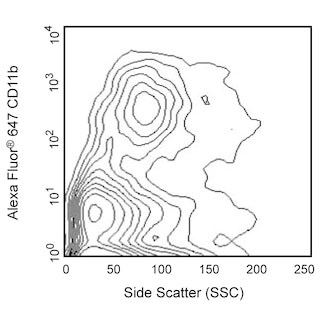Old Browser
Looks like you're visiting us from {countryName}.
Would you like to stay on the current country site or be switched to your country?


.png)

Multicolor flow cytometric analysis of CX3CR1 expression on mouse splenocytes. C57BL/6 mouse splenocytes were preincubated with Purified Rat Anti-Mouse CD16/CD32 antibody (Mouse BD Fc Block™) (Cat. No. 553141/553142), then stained with Alexa Fluor™ 647 Rat Anti-Mouse CD11b (Cat. No. 557686) and either PE Rat IgG2a, κ Isotype Control (Cat. No. 553930; Left Plot) or PE Rat Anti-Mouse CX3CR1 antibody (Cat. No. 567530; Right Plot) at 0.125 μg/test. Bivariate pseudocolor density plots showing the correlated expression of CX3CR1 versus CD11b (or Ig Isotype control staining) were derived from gated events with the forward and side light-scatter characteristics of intact cells. Flow cytometric analysis was performed using a BD LSRFortessa™ X-20 Cell Analyzer System equipped with a Blue Laser. Data shown on this Technical Data Sheet are not lot specific.
.png)

BD Pharmingen™ PE Rat Anti-Mouse CX3CR1
.png)
Regulatory Status Legend
Any use of products other than the permitted use without the express written authorization of Becton, Dickinson and Company is strictly prohibited.
Preparation And Storage
Recommended Assay Procedures
BD™ CompBeads can be used as surrogates to assess fluorescence spillover (Compensation). When fluorochrome conjugated antibodies are bound to BD™ CompBeads, they have spectral properties very similar to cells. However, for some fluorochromes there can be small differences in spectral emissions compared to cells, resulting in spillover values that differ when compared to biological controls. It is strongly recommended that when using a reagent for the first time, users compare the spillover on cells and BD CompBeads to ensure that BD™ CompBeads are appropriate for your specific cellular application.
Product Notices
- Since applications vary, each investigator should titrate the reagent to obtain optimal results.
- An isotype control should be used at the same concentration as the antibody of interest.
- Caution: Sodium azide yields highly toxic hydrazoic acid under acidic conditions. Dilute azide compounds in running water before discarding to avoid accumulation of potentially explosive deposits in plumbing.
- Please refer to www.bdbiosciences.com/us/s/resources for technical protocols.
- For fluorochrome spectra and suitable instrument settings, please refer to our Multicolor Flow Cytometry web page at www.bdbiosciences.com/colors.
- Please refer to http://regdocs.bd.com to access safety data sheets (SDS).
Companion Products




.png?imwidth=320)

The Z8-50.23 monoclonal antibody specifically recognizes the mouse CX3C chemokine receptor 1 (CX3CR1), which is also known as Fractalkine receptor, G protein-coupled receptor 13 (GPR13), or GPRV28 (V28). CX3CR1 is an ~40 kDa, seven-transmembrane G protein-coupled receptor that is expressed on monocytes, activated macrophages, NK cells, a subset of memory T cells, dendritic cells (DC), and mast cells. CX3CR1 is a receptor for the CX3C chemokine, CX3CL1, which is also known as fractalkine or neurotactin. CX3CL1 is expressed on activated endothelial cells, neurons, and astrocytes. CX3CR1 plays a role in leucocyte adhesion and extravasation from blood vessels during inflammation.

Development References (4)
-
Combadiere C, Gao J, Tiffany HL, Murphy PM. Gene cloning, RNA distribution, and functional expression of mCX3CR1, a mouse chemotactic receptor for the CX3C chemokine fractalkine.. Biochem Biophys Res Commun. 1998; 253(3):728-32. (Biology). View Reference
-
Gerlach C, Moseman EA, Loughhead SM, et al. The Chemokine Receptor CX3CR1 Defines Three Antigen-Experienced CD8 T Cell Subsets with Distinct Roles in Immune Surveillance and Homeostasis. Immunity. 2016; 45(6):1270-1284. (Biology). View Reference
-
Imai T, Yasuda N. Therapeutic intervention of inflammatory/immune diseases by inhibition of the fractalkine (CX3CL1)-CX3CR1 pathway.. Inflamm Regen. 2016; 36:9. (Biology). View Reference
-
Li N, Jiang P, Chen A, et al. CX3CR1 positively regulates BCR signaling coupled with cell metabolism via negatively controlling actin remodeling. Cell Mol Life Sci. 2020; 77(22):4379-4395. (Biology). View Reference
Please refer to Support Documents for Quality Certificates
Global - Refer to manufacturer's instructions for use and related User Manuals and Technical data sheets before using this products as described
Comparisons, where applicable, are made against older BD Technology, manual methods or are general performance claims. Comparisons are not made against non-BD technologies, unless otherwise noted.
For Research Use Only. Not for use in diagnostic or therapeutic procedures.
Refer to manufacturer's instructions for use and related User Manuals and Technical Data Sheets before using this product as described.
Comparisons, where applicable, are made against older BD technology, manual methods or are general performance claims. Comparisons are not made against non-BD technologies, unless otherwise noted.
Report a Site Issue
This form is intended to help us improve our website experience. For other support, please visit our Contact Us page.